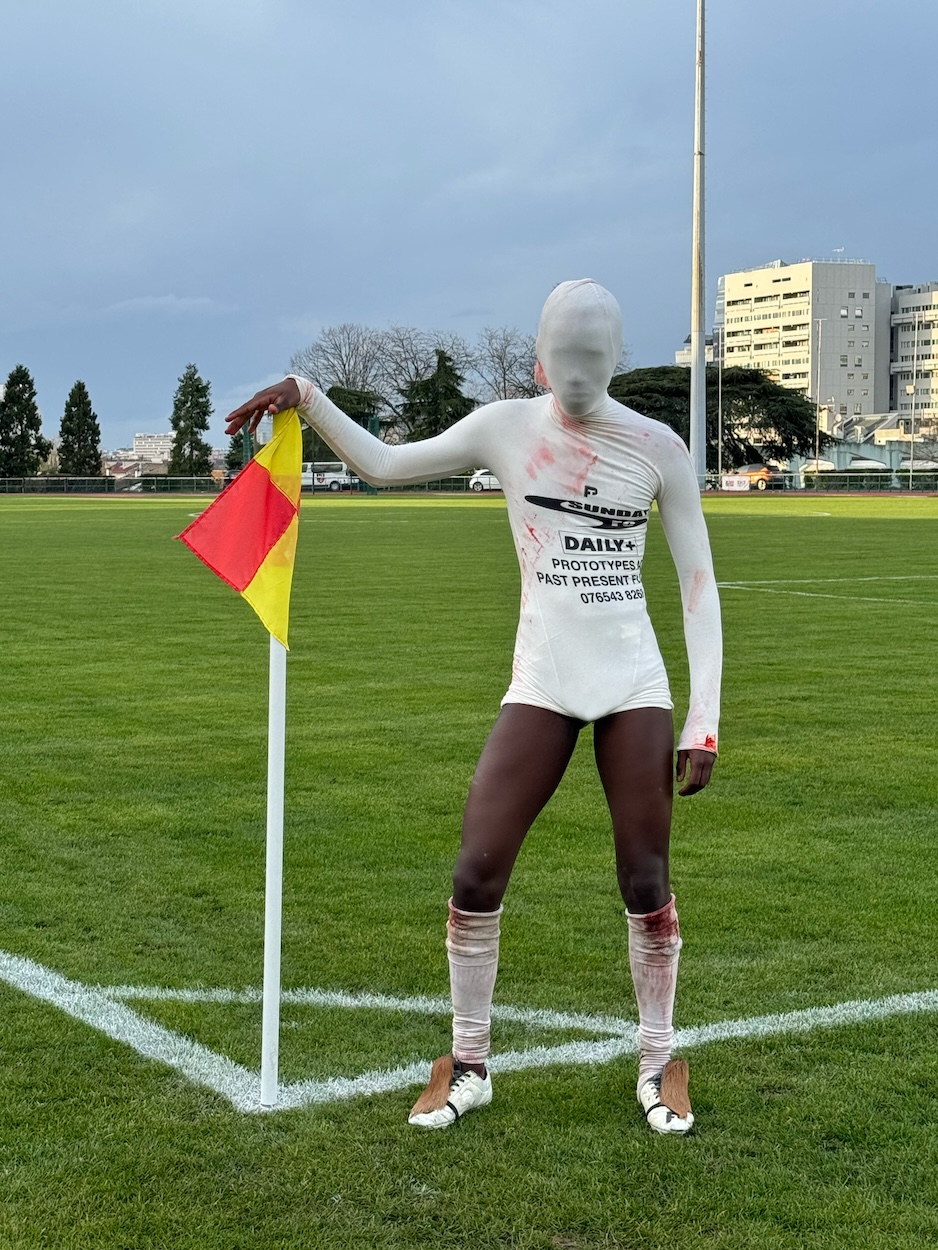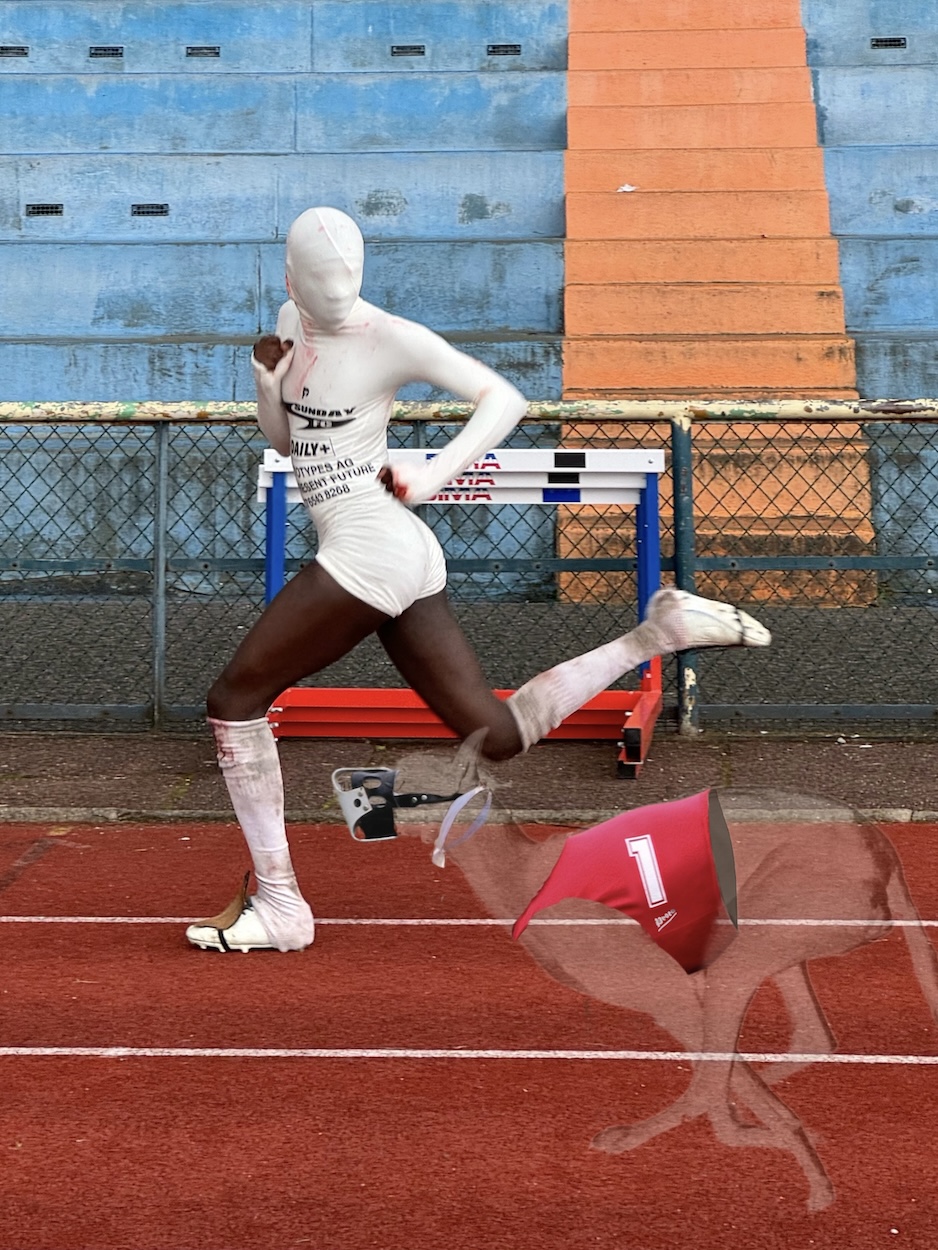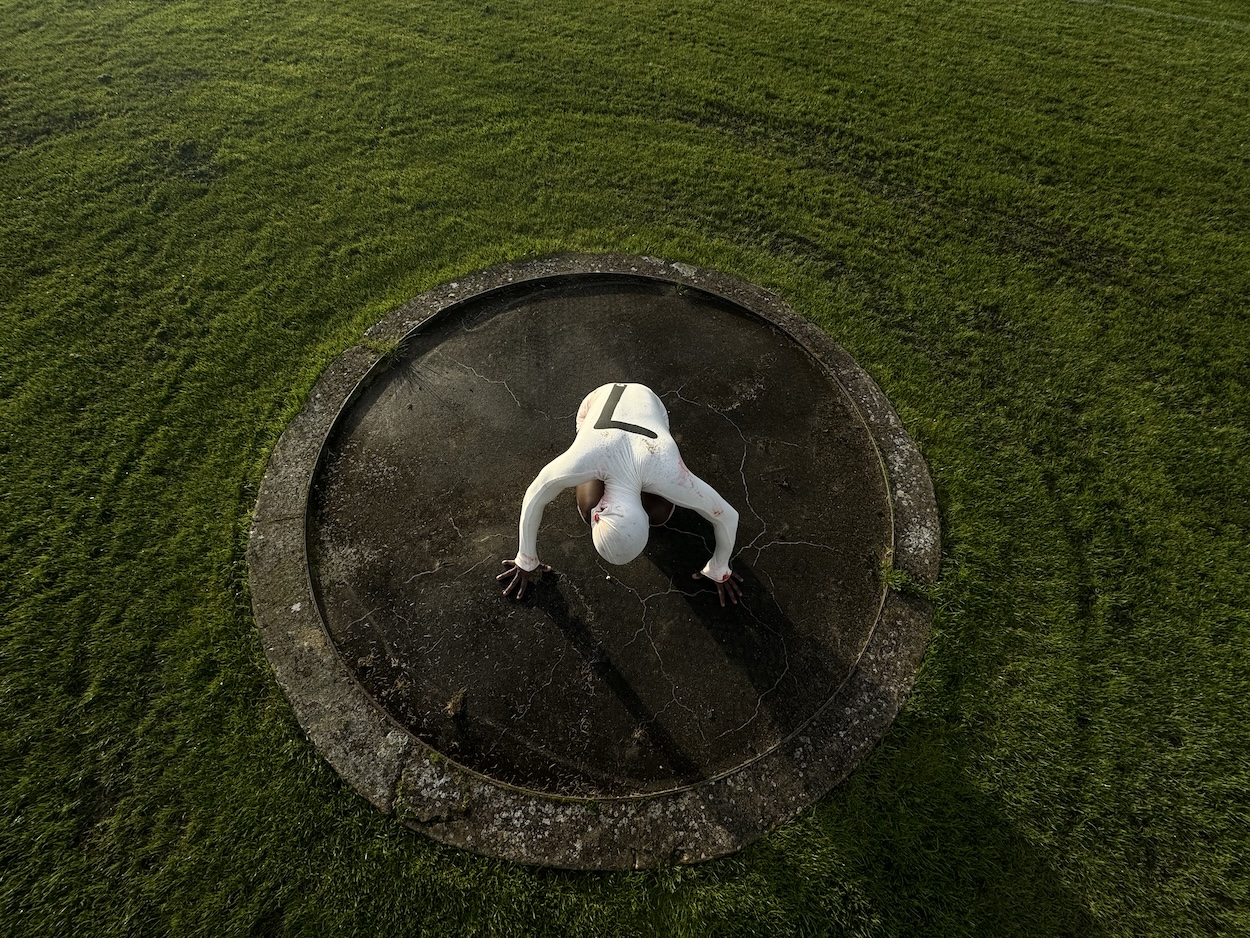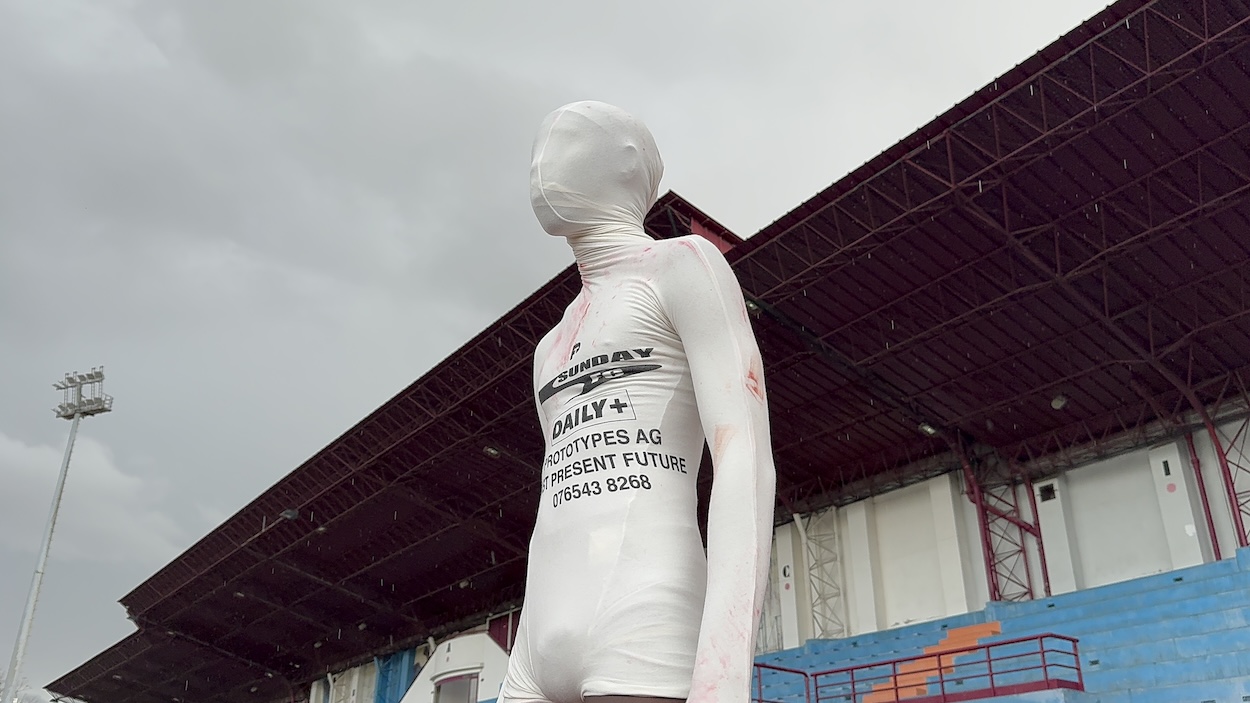
IN CONVERSATION WITH SOPHIE THATCHER
Sophie Thatcher, best known for her role in the critically acclaimed series…
Photography by Jason Renaud; Interview by Louise Garier




Zurich-based, emerging brand Prototypes is on a mission: changing the status quo in the most creative way possible and re-educating a system that is sleeping on its privileges.
On June, 19th the brand will be back in Paris with a big show presenting the universe of Series 07, which will explore the complex world of Football Ultras, dedicated to football fans for whom football is more than a way of life. For their previous Series 06, the two creatives staged various characters within the culture of Football. Numéro Berlin spoke to co-founder Laura Beham about why eating other people’s waste and making the impossible possible is the only future. A Kanye-approved success story.
Since day one of its birth in 2021, Prototypes – founded by German designer Laura Beham and British designer Callum Pidgeon – wants to make a point: a big change in the fashion industry is not only needed but inevitable. Enough talking; we have all seen the outcomes of our ignorance. What we need is a massive mental training to start thinking more innovatively and designers like Beham and Pidgeon whose passion, creativity and smart, future-oriented approach to fashion feel like moving mountains. Their last collection that they presented during Paris Fashion Week made a lot of noise that was particularly supported by genius Kanye West who is a big supporter and mentoring partner for the two creatives. He posted the entire collection – that was shot on the soccer field of Long Buckby football club, for which Pidgeon used to play – on his Instagram account. We haven’t seen fashion using football in this way: as a symbol of unification, designed of mostly upcycled sportswear. And what is furthermore so special about the brand: their liberal understanding of ownership. Instead of fueling competition, Beham and Pidgeon prefer to share their ideas (and even offer patterns and instructions on their website, so customers are able to produce their own Prototypes pieces). A story that gives hope.
Laura Beham: It is the club in which Callum used to play as a teenager. We traveled there to shoot the campaign and as a big thank you, we are now sponsoring their women’s football team, they play in Prototypes now.
No one really goes deeper when it comes to football, there is more than just the famous players, there is a whole culture and society behind. We are telling their story: we have the player represented, the groundsman, the club president’s wife, the hooligans, the coach, the security, the guy who has to go to practice with his child because he’s a young dad, the supportive grandma, the injured person etc. We try to show the whole society behind football, not just the hype. All these characters give the collection a unique point of view.
Soccer is unifying, it is really about bringing people together and everyone can join, there is no age limit to soccer. And it’s approachable for everyone. All you need is a ball, and you can go outside and just find a new friend. It is about being a team and encouraging people to have an opinion. (Heads toward the collection pieces): Look at this latex silhouette, isn’t that amazing?
I did it in the football club before the campaign shoot – when I knew which model would be wearing it, I was like ‘ok, let’s put this together’. It was quite a ride.
“We try to show the whole society behind football, not just the hype. All these characters give the collection a unique point of view”
The police ladies wear an upside down jacket because we don’t really believe in the police.
It really depends. A lot is handpicked; we spend a lot of time and love into the sourcing process; it is very important to us. There are a lot of military places with great dead stock, and so many brands have an amazing one too. The future for me lies not in collaborations the way we see them now, but in working more with what is being left season after season – eating other people’s waste and making something out of it. We all need to be way more responsible with what we put out there.
Yes, this one here, for example, I handshaped it. We use fur for good reason because it has been overproduced in the past century for so many years. And this is something that will leave the ground. I have a big issue with this vegan leather trend, it is just plastic, and it will never leave the ground. I do not believe that any design is that good that it should never leave the ground.
This poncho here comes from German dead stock from the Second World War, and this dress is made out of bra closures that we put into a row to create a studded-looking evening dress. These designs here are made out of old football shirts, which are too small, so nobody could wear them; we just added paneling to them.
We wanted to find our own way of designing that could show a new direction and a new path for the future of fashion. Designers nowadays are problem solvers for me. Like, really, look at what we have done with our fashion system? This terrible overproduction—what are we going to do with it? I say, let’s find new creative solutions. There is so much out there that is dead stock. You don’t have to stonewash a T-shirt 5000 times. Finally, starting this year, we are not allowed anymore to burn our clothes (according to a new EU law, S.B.). This will hopefully force people to reflect on what to do with it. It is the heart and base of Prototypes to think about what we can do with things we don’t need anymore. In that sense, it is about eating other people’s waste.
Yes. For example, we do denims and the shape is all the same, but the details aren’t, whatever we upcycle is slightly different and therefore unique, it is one of a kind which I think feeds into new generation and social media – everyone wants to be special, but still a part – so how can you supply both? I think, the best way to do it is by upcycling, by reworking and deconstructing what is already there so you can still see where something is coming from. Like here – this piece originates from a sock, this from a scarf. It makes you smile and motivates you to have fun with it, it is all about playing around and experiment.
“This terrible overproduction—what are we going to do with it? I say, let’s find new creative solutions. There is so much out there that is dead stock”
Yes, one of my favorite concepts of this season was that we moved necklines. This creates a whole new amazing boxy shape. The approach really is to follow the function of a shape.
Oh no, designing for me is playtime. I dress myself, see what happens, and experiment on how many ways I can wear a t-shirt. So it’s a bit like, where can I put my head through, where can I put a leg in. Fashion is about having fun, having great characters and doing things differently.
I mean the pace we have to develop things, the crazy fashion rhythm, is insane, it is not healthy. I personally have a big issue with it. In the end all is defined by the retail or the buyers that decide when they have budget and when they don’t so we all have to run to the factories at the same time, always wanting to be the first ones in line. Then comes the delivery window and the sales window. We would be so much happier if we were a bit more free and able to choose what makes most sense and when. Nobody needs a new wardrobe four times a year.
Everybody does. It’s really difficult, and I think what we try to do, especially with this collection, is to bring it back to the emotional part, the experimenting side.
Question everything! Is there a need for it or not? When Callum and I started working with Kayne West for Yeezy, we learned so much as well. Kanye has been one of the best mentors I’ve ever had in my life, always pushing for more and better. He understood way before others what innovation can do good. He made us better designers. He pushed and trained us; he is such a genius mind. It is a great partnership we have with him, and we are very grateful for it. It really has been a blessing to work with both Kayne and Demna.
Making the impossible possible. There was one day when I was doing overalls for him, and he pushed me to do another one and another one and another one, so I ended up doing 32. And I was like, oh God, I’m going crazy. What am I going to do? And all of a sudden, it just clicked and I found a solution. It’s him knowing that there is a solution out there but letting the person figure it out by him/herself, this makes him such a great mentor. He really sees the future; I do believe that. He knows there needs to be a change in this industry and that smaller brands like us need to be given visibility.
“Kanye has been one of the best mentors I’ve ever had in my life, always pushing for more and better. He understood way before others what innovation can do good”
He discovered us over a year ago and just called us: I love what you do; let’s work together. This was so, so special, and we’re both extremely thankful for it. I could have not asked for anything better, but for this massive workout, it really is a bit like mental training. You have to train your brain to get out of these rules and boxed thinking. When you attend fashion school and you learn pattern making you constantly work with rules that tell you what you can do and what you can’t do. Like, this is how you make your sleeve, this is how you make a leg. But no, this is not true. There are a million ways how to do it. And Kanye is exactly the person to tell you, you can do it; you will figure it out.
Yes, it changes everything. There is always a way, and you don’t have to listen to people saying no. We really need some anarchy, that will build new energy.
…seeing our responsibilities. We are still young, but I already feel responsible for the new generation. What are they going to do? I personally think that the study of fashion design and the way it’s taught have to change. We have to give people a brighter education. And we have to make sure that when people study fashion, they know how to survive after working as professionals. And then, not everyone is extremely creative and needs to be a designer; there are so many job descriptions within fashion that you don’t easily get to know. If you’re not privileged enough to have money to attend a really good school – what do you do? It’s so hard. My biggest passion, for example, is draping and pattern making, but is a dying art. Nobody wants to do it anymore because everyone wants to be a designer. I mean, everyone can find decent pictures and put a moodboard together, but what about making something 3D? Designers are proper craftsmen; the difference is that I work with a human body instead of a table or a chair, but you are not going to reinvent the wheel. I hate this topic in fashion – for sure, everything has already been there at some point, and that is ok. It is about paying homage to it.
Yes, we offer DIY instructions for how to make some of our bestselling pieces, like sweatpants or hoodies from past seasons. DIY for home. We really want to share the knowledge of how to make it. There’s not only this one person who can do it; everyone can be creative and design or construct. I really want everyone to be encouraged and motivated. Fashion should make you feel better. Let’s understand that there is no ownership; these times are over. My brain should be everyone’s brain. I want to share my knowledge.
I don’t know yet. There should be the right platforms and panel talks. The fashion industry is not only responsible for showing the latest coolest whatever; I think we’re also responsible for speaking up about what’s not good, looking at problems and trying to improve, together. We need to start talking and exchanging. We need to start giving opportunities to those kids and young people that do not have the amazing background to attend Central St Martins or whatsoever. There’s so much for everyone to explore.
I actually applied to a fashion school and studied for two semesters in Berlin. And to be very honest, I found it fucking stupid, almost like a joke. I really thought it was ridiculous to just teach someone to put as many weird concepts together as possible and not to speak about how much it would cost in production, like basic skills. I had the shittiest grades and was like, fuck it, I’m going to drop out. So they were like, if you did a small internship, you could maybe get some credits for your future. And then I ended up at Vetements and stayed longer as planned since Demna saw some potential in me; that literally was my school. There, I learned everything. I learned going to factories, development, production, showroom selling – there is so much that comes along with designing, and I think the biggest issue is that so many great creatives don’t know it. Just by putting it on social media, you will, in the worst case, end up with someone stealing it from you. How do we protect ourselves? How do we build a platform? How can we share? How can people find a job? How do they apply? Thank God, I haven’t been through that process because it is overwhelming. We have to give hope to the future generation. We need to start acting as a support system for each other.
“We need to start giving opportunities to those kids and young people that do not have the amazing background to attend Central St Martins or whatsoever. There’s so much for everyone to explore”
Unfortunately, the fashion industry, together with the oil industry, is one of the worst polluting industries in the world. Let’s try to find a way to work within our limitations, and let’s make this the fun part. I love to work with limitations. I always feel like the more limited you are, the more creative you can be. I think upcylcing needs to be taught at schools, or at least how to place patterns in a way that you don’t have to cut off waste. And also, what do you do with cut off waste? For example, we use it and reproduce it. With leftovers, we sometimes make mini skirts or scarves. This is why our seasons are always interlinked.
Correct.
“I love to work with limitations. I always feel like the more limited you are, the more creative you can be”
Yes. What we find or what we can source defines the collection. I think it’s a fun way to see it, it’s a challenge. We got this one collection for which we used all ties – it was crazy, I wanted to kill myself. We had these 5000 ties in front of us and were like fuck, what are we going to do? And then we started to design full tailoring and full shirting. For production, it was also a challenge: factories are still getting used to our way of working, in which they don’t have any plain fabric to work with but need to take pieces apart. So the sewer and seamstresses really get a new education, normally they are responsible for just one element like the sleeves or so. Now they have to work with the full piece to understand what can be taken apart and flipped around. They learn how to reconstruct. This is at first confusing, we always have to send instructions along, but for them to learn it means they learn a new way of producing, which is the future.
We mainly produce in Italy and Portugal; Portugal is great for Jersey. For denim, we are now starting a conversation with Turkey. We visit all of our factories ourselves due to the difficulty of the product.
Yeezy is planning to, yes, but I cannot talk about it as of now. Our partnership will surely be continued. June will be insane; we’re going to grow so much more, and it is going to be very hard. We will go so hard.

Sophie Thatcher, best known for her role in the critically acclaimed series…
Photography by Jason Renaud; Interview by Louise Garier

"We have to create something that has a purpose and is useful. And not forced by the…
Interview Carolin Desiree Becker

Supporting Sydney’s cultural scene: This month’s collaboration reminds us of happy…
Interview by Sina Braetz